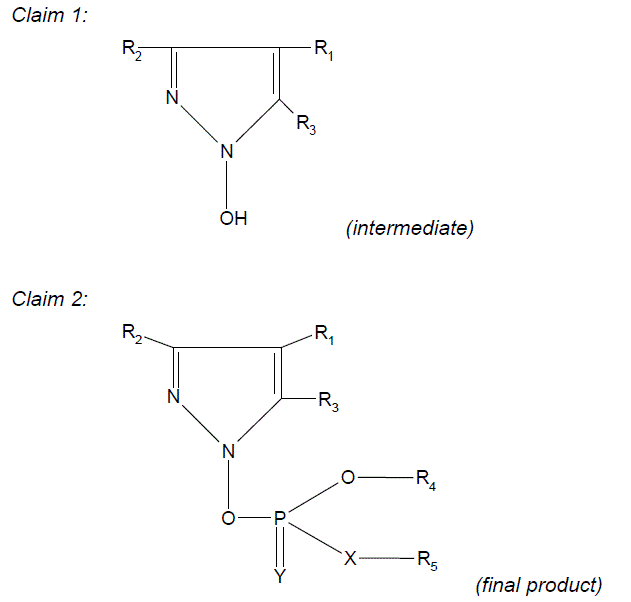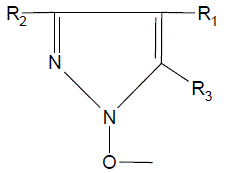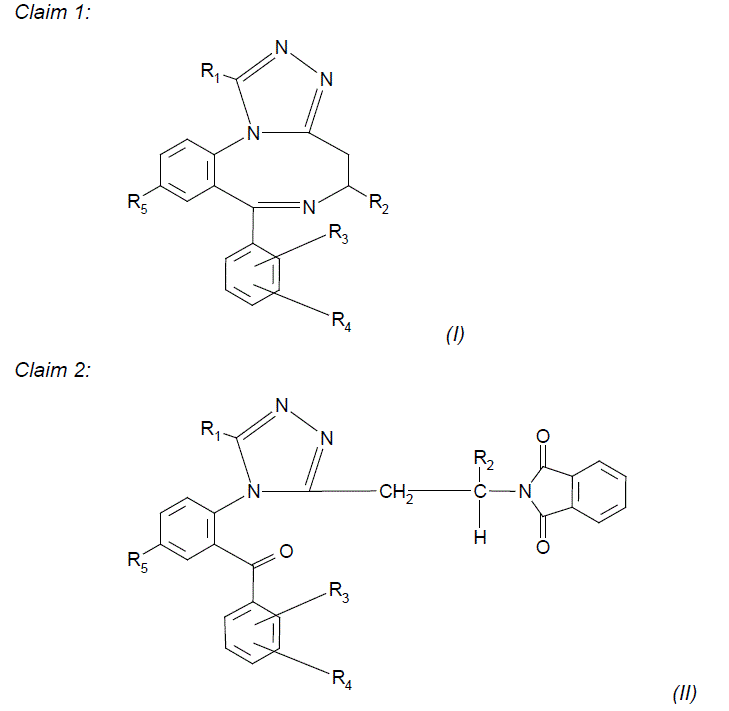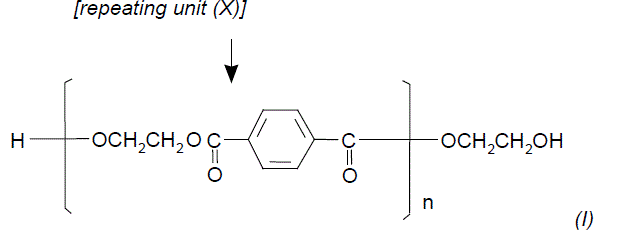PCT International Search and Preliminary Examination Guidelines
PART III EXAMINER CONSIDERATIONS COMMON TO BOTH THE INTERNATIONAL SEARCHING AUTHORITY AND THE INTERNATIONAL PRELIMINARY EXAMINING AUTHORITY
Chapter 10 Unity of Invention
Different Aspects of the Invention Claimed (Method, Apparatus, Product etc.)
Unity of Invention Exists - Examples 1 to 14
10.21 Example 1
Claim 1: A method of manufacturing chemical substance X.
Claim 2: Substance X.
Claim 3: The (method of) use of substance X as an insecticide.
Unity exists a priori between claims 1, 2 and 3 because the special technical feature common to all the claims is substance X. However, if substance X does not define a contribution over the prior art, there would not be a special technical feature common to all the claims. Accordingly, unity may be lacking (see paragraph 10.20).
Claim 1: Use of a family of compounds X as insecticides.
Claim 2: Compound X1 belonging to the family of compounds X.
Unity exists between claims 1 and 2. The special technical feature is the use of the family of compounds X as an insecticide, provided X1 has the insecticidal property.
Claim 1: A high corrosion resistant and high strength ferritic stainless steel strip consisting essentially of, in percent by weight: Ni=2.0-5.0; Cr=15-19; Mo=1-2; and the balance Fe, having a thickness of between 0.5 and 2.0 mm and a 0.2% yield strength in excess of 50 kg/mm squared.
Claim 2: A method of producing a high corrosion resistant and high strength ferritic stainless steel strip consisting essentially of, in percent by weight: Ni=2.0-5.0; Cr=15-19; Mo=1-2; and the balance Fe, comprising the steps of:
(a) hot rolling to a thickness between 2.0 and 5.0 mm;
(b) annealing the hot rolled strip at 800-1000°C under substantially no oxidizing conditions;
(c) cold rolling the strip to a thickness of between 0.5 and 2.0 mm; and
(d) final annealing the cold rolled strip at between 1120 and 1200°C for a period of 2-5 minutes.
Unity exists between product claim 1 and process claim 2. The special technical feature in the product claim is the 0.2% yield strength in excess of 50 kg/mm squared. The process steps in claim 2 inherently produce a ferritic stainless steel strip with a 0.2% yield strength in excess of 50 kg/mm squared. Even if this feature is not apparent from the wording of claim 2, it is clearly disclosed in the description. Therefore the process steps are the special technical feature which correspond to the limitation in the product claim directed to the same ferritic stainless steel with the claimed strength characteristics.
Claim 1: Filament A for a lamp.
Claim 2: Lamp B having filament A.
Claim 3: Searchlight provided with lamp B having filament A and a swivel arrangement C.
Unity exists between claims 1, 2, and 3. The special technical feature common to all the claims is the filament A.
Claim 1: A marking device for marking animals, comprising a disc-shaped element with a stem extending normally therefrom, the tip of which is designed to be driven through the skin of the animal to be marked, and a securing disk element to be fastened to the protruding tip of the stem on the other side of skin.
Claim 2: An apparatus for applying the marking device of claim 1, constructed as a pneumatically actuated gun for driving the stem of the disc-shaped element through the skin, and provided with a supporting surface adapted for taking up a securing disc element, to be placed at the other side of the body portion in question of the animal to be marked.
The special technical feature in claim 1 is the marking device having a disc-shaped element with a stem and a securing disc element to be fastened to the tip of the stem. The corresponding special technical feature in claim 2 is the pneumatically actuated gun for driving the marking device and having a supporting surface for the securing disc element. Unity exists between claims 1 and 2.
Claim 1: Compound A.
Claim 2: An insecticide composition comprising compound A and a carrier.
Unity exists between claims 1 and 2. The special technical feature common to all the claims is compound A.
Claim 1: An insecticide composition comprising compound A (consisting of a1, a2...) and a carrier.
Claim 2: Compound a1.
All compounds A are not claimed in the product claim 2 for reasons of lack of novelty of some of them for instance.
There is nevertheless still unity between the subject matter of claims 1 and 2 provided a1 has the insecticidal activity that is also the special technical feature for compound A in claim 1.
10.28 Example 8 (Intermediate/Final Product)

The chemical structures of the intermediate and final product are technically closely interrelated. The essential structural element incorporated into the final product is:

Therefore, unity exists between claims 1 and 2.
10.29 Example 9 (Intermediate/Final Product)

(II) is described as an intermediate to make (I). The closure mechanism is one well known in the art. Though the basic structures of compound (I) (final product) and compound (II) (intermediate) differ considerably, compound (II) is an open ring precursor to compound (I). Both compounds share a common essential structural element that is the linkage comprising the two phenyl rings and the triazole ring. The chemical structures of the two compounds are therefore considered to be technically closely interrelated.
The example therefore satisfies the requirement for unity of invention.
10.30 Example 10 (Intermediate/Final Product)
Claim 1: Amorphous polymer A (intermediate).
Claim 2: Crystalline polymer A (final product).
In this example a film of the amorphous polymer A is stretched to make it crystalline.
Here unity exists because there is an intermediate final product relation in that amorphous polymer A is used as a starting product to prepare crystalline polymer A.
For purposes of further illustration, assume that the polymer A in this example is polyisoprene. Here the intermediate, amorphous polyisoprene, and the final product, crystalline polyisoprene, have the same chemical structure.
10.31 Example 11 (Intermediate/Final Product)
Claim 1: Polymeric compound useful as fiber material identified by the following general formula:

Claim 2: Compound identified by the following general formula:
(useful as intermediate for polymeric compound I)

The two inventions are in an intermediate and final product relationship.
Substance (II) is a raw material for substance (I).
Meanwhile, both compounds share an essential structural element (repeating unit (X)) and are technically closely interrelated. The intermediate and final products therefore satisfy the requirements for unity.
10.32 Example 12 (Intermediate/Final Product)
Claim 1: Novel compound having structure A (intermediate).
Claim 2: Product prepared by reacting A with a substance X (final product).
(see below for further details)
10.33 Example 13 (Intermediate/Final Product)
Claim 1: Reaction product of A and B (intermediate).
Claim 2: Product prepared by reacting the reaction product of A and B with substances X and Y (final product).
In examples 12 and 13 the chemical structure(s) of the intermediate and/or the final product is not known. In 12 the structure of the product of claim 2 (the final product) is not known. In 13 the structures of the products of claim 1 (the intermediate) and claim 2 (the final product) are unknown.
Unity exists if there is evidence that would lead one to conclude that the characteristic of the final product which is the inventive feature in the case is due to the intermediate. For example, the purpose for using the intermediates in Examples 12 and 13 is to modify certain properties of the final product. The evidence may be in the form of test data in the specification showing the effect of the intermediate on the final product. If no such evidence exists then there is no unity on the basis of an intermediate-final product relationship.
10.34 Example 14(A) (Protein and its Encoding DNA)
Claim 1: Isolated protein X having SEQ ID NO: 1.
Claim 2: Isolated DNA molecule encoding protein X of claim 1.
(Some Authorities presume that a claimed biological molecule is in isolated form and therefore do not require the claim to explicitly include the term "isolated" as above.)
The disclosure teaches that protein X is an interleukin-1, a soluble cytokine involved in the activation of lymphocytes. The disclosure also sets forth a DNA molecule having SEQ ID NO: 2 that encodes SEQ ID NO: 1.
There is no prior art and so SEQ ID NO:1 and SEQ ID NO:2 are both novel and inventive.
The claimed DNA molecule encodes protein X, and therefore protein X and the DNA encoding protein X share a corresponding technical feature. Consequently, the claims have unity of invention (a priori).
Please note that although it is generally accepted that DNA and the corresponding encoded protein share unity of invention a priori, given the special relationship between these two classes of molecules (i.e., DNA encodes protein following the well-known genetic code), some Authorities may hold that exceptions exist as noted below.
Further, because protein X makes a contribution over the prior art, protein X and the DNA encoding protein X share a special technical feature a posteriori.
Example 14(B)
If an alternative DNA claim was presented that encompassed a DNA molecule that did not encode protein X, some Authorities might find that the claims did not share the same or corresponding technical feature and therefore lacked unity a priori. Examples of such claims are:
Claim 3: Isolated DNA molecule encoding protein X, or a DNA fragment thereof.
Claim 4: Isolated DNA molecule having SEQ ID NO: 2, or DNA molecules which hybridize to the complement of SEQ ID NO: 2 under stringent conditions.
Some Authorities may consider claim 3 to lack unity on the basis that the DNA fragment and the hybridizing DNA molecules are not limited to encoding protein X. Other Authorities may interpret "DNA fragment thereof" or hybridizing molecules as being derived from the DNA molecule and representative of the same general inventive concept, and therefore consider unity to be present.
DNA molecules which hybridize to the complement of SEQ ID NO: 2 under stringent conditions share significant identity to SEQ ID NO: 2. Therefore, some Authorities may consider claim 4 to be directed to the same general inventive concept, and therefore consider unity to be present.
If prior art existed teaching either protein X or the DNA encoding protein X, some Authorities might find that the same or corresponding technical feature did not make a contribution over the prior art, that is, was not a special technical feature, and therefore unity was lacking (a posteriori).
Example 14(C)
In addition, if it was thought that a finding of unity of invention a priori for a protein (or a class of proteins) and a nucleic acid (or a class of nucleic acids) would conflict with other guidance, such as the Markush test, some Authorities might find that the claims do not share the same or corresponding special technical feature and therefore lack unity of invention a priori or a posteriori depending on the facts.
Examples of such claims are:
Claim 5: An isolated protein with function X.
Claim 6: Isolated DNA molecules encoding a protein with function X selected from the group consisting of SEQ ID NO: 1, SEQ ID NO: 2, and SEQ ID NO: 3.
If SEQ ID NOs: 1 to 3 lack unity a priori under the "Markush test" (e.g., fail parts (B)(1) and (B)(2) of the Markush test in paragraph 10.17) because the DNA SEQ ID NOs: 1 to 3 encode structurally distinct proteins from different families that are not structurally/evolutionarily related (such as, for instance, the subtilisin-like and chymotrypsin-like serine proteases that are known to coincidentally possess the same serine protease function even though they have completely different structures and belong to evolutionarily distinct families), some Authorities might find that unity of invention does not exist a priori between the isolated DNA SEQ ID NOs: 1-3 and corresponding encoding proteins with function X.
No Unity of Invention (a priori) - Examples 15 to 16
Claim 1: A process for treating textiles comprising spraying the material with a particular coating composition under special conditions (for example, as to temperature, irradiation).
Claim 2: A textile material coated according to the process of claim 1.
Claim 3: A spraying machine for use in the process of claim 1 and characterized by a new nozzle arrangement providing a better distribution of the composition being sprayed.
The process according to claim 1 imparts unexpected properties to the product of claim 2. The special technical feature in claim 1 is the use of special process conditions corresponding to what is made necessary by the choice of the particular coating. Unity exists between claims 1 and 2. The spraying machine in claim 3 does not correspond to the above identified special technical feature. Unity does not exist between claim 3 and claims 1 and 2.
Claim 1: A fuel burner with tangential fuel inlets into a mixing chamber.
Claim 2: A process for making a fuel burner including the step of forming tangential fuel inlets into a mixing chamber.
Claim 3: A process for making a fuel burner including casting step A.
Claim 4: An apparatus for carrying out a process for making a fuel burner including feature X resulting in the formation of tangential fuel inlets.
Claim 5: An apparatus for carrying out a process for making a fuel burner including a protective housing B.
Claim 6: A process of manufacturing carbon black including the step of tangentially introducing fuel into a mixing chamber of a fuel burner.
Unity exists between claims 1, 2, 4, and 6. The special technical feature common to all the claims is the tangential fuel inlets. Claims 3 and 5 lack unity with claims 1, 2, 4, and 6 since claims 3 and 5 do not include the same or corresponding special technical feature as set forth in claims 1, 2, 4, and 6. Claims 3 and 5 would also lack unity with one another.